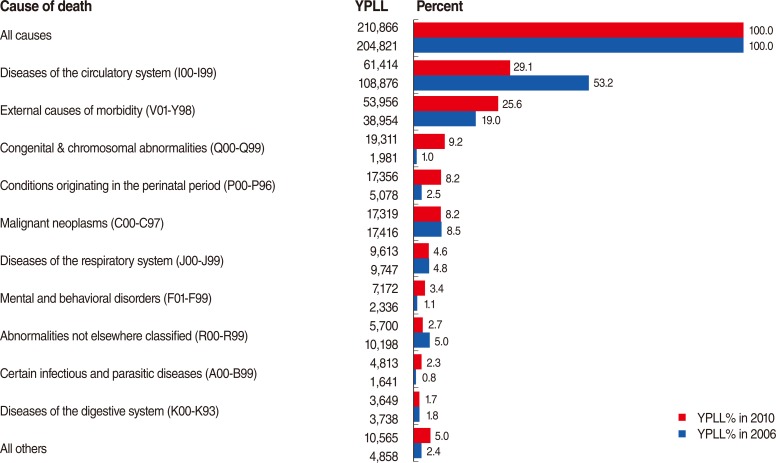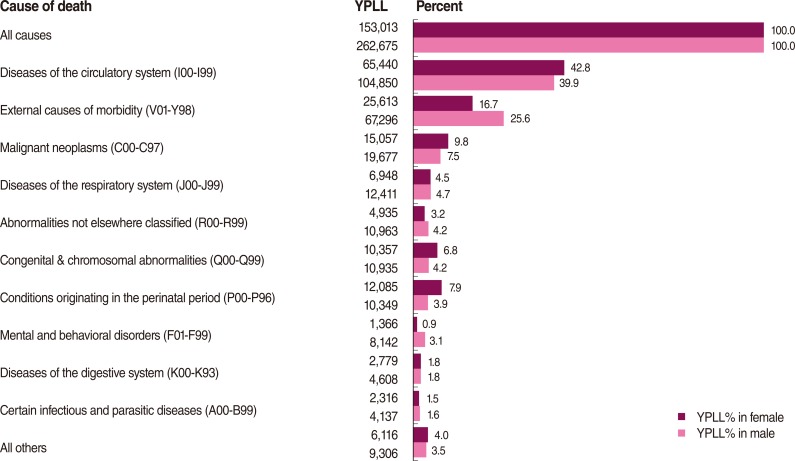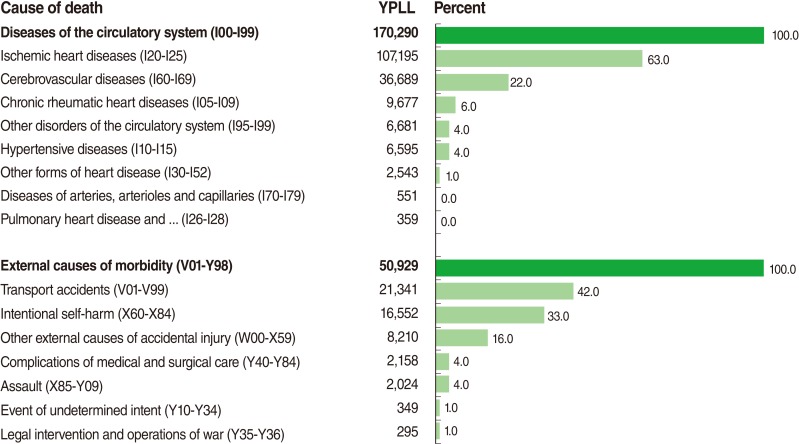Articles
- Page Path
- HOME > Epidemiol Health > Volume 34; 2012 > Article
-
Original Article
The Burden of Premature Mortality in Hamadan Province in 2006 and 2010 Using Standard Expected Years of Potential Life Lost: A Population-based Study - Jalal Poorolajal1, Nader Esmailnasab2, Jamal Ahmadzadeh3, Tahereh Azizi Motlagh4
-
Epidemiol Health 2012;34:e2012005.
DOI: https://doi.org/10.4178/epih/e2012005
Published online: August 31, 2012
1Research Center for Health Sciences, Department of Epidemiology & Biostatistics, School of Public Health, Hamadan University of Medical Sciences, Hamadan, Iran.
2Department of Community Medicine, School of Medicine, Kurdistan University of Medical Sciences, Kurdistan, Iran.
3Department of Epidemiology & Biostatistics, School of Public Health, Hamadan University of Medical Sciences, Hamadan, Iran.
4Vice-Chancellor of Health Services, Hamadan University of Medical Sciences, Hamadan, Iran.
- Correspondence: Jalal Poorolajal, MD, PhD. Research Center for Health Sciences, Department of Epidemiology & Biostatistics, School of Public Health, Hamadan University of Medical Sciences, Shahid Fahmideh Ave., Hamadan 6517838695, Iran. Tel: +98-811-8380090, Fax: +98-811-8380509, poorolajal@umsha.ac.ir
© 2012, Korean Society of Epidemiology
This is an open-access article distributed under the terms of the Creative Commons Attribution License (http://creativecommons.org/licenses/by/3.0), which permits unrestricted use, distribution, and reproduction in any medium, provided the original work is properly cited.
- 16,546 Views
- 126 Download
- 11 Crossref
Figure & Data
References
Citations

- Suicidal behaviors among intravenous drug users: a meta-analysis
Bahram Armoon, Marie-Josée Fleury, Azadeh Bayani, Rasool Mohammadi, Elaheh Ahounbar, Mark D. Griffiths
Journal of Substance Use.2024; 29(1): 10. CrossRef - The Role of Social Support in Preventing Suicidal Ideations and Behaviors: A Systematic Review and Meta-Analysis
Nahid Darvishi, Jalal Poorolajal, Bita Azmi-Naei, Mehran Farhadi
Journal of Research in Health Sciences.2024; 24(2): e00609. CrossRef - Diabetes in southern Iran: a 16-year follow-up of mortality and years of life lost
Habibollah Azarbakhsh, Mohammad Hossein Sharifi, Jafar Hassanzadeh, Rebecca Susan Dewey, Maryam Janfada, Alireza Mirahmadizadeh
International Journal of Diabetes in Developing Countries.2023; 43(4): 574. CrossRef - Premature Death, Underlying Reasons, and Preventive Experiences in Iran: A Narrative Review
Iman Razeghian-Jahromi, Yasin Ghasemi Mianrood, Mahintaj Dara, Pouria Azami
Archives of Iranian Medicine.2023; 26(7): 403. CrossRef - Prevalence, sociodemographic variables, mental health condition, and type of drug use associated with suicide behaviors among people with substance use disorders: a systematic review and meta-analysis
Bahram Armoon, Neda SoleimanvandiAzar, Marie-Josée Fleury, Alireza Noroozi, Amir-Hossein Bayat, Rasool Mohammadi, Elahe Ahounbar, Ladan Fattah Moghaddam
Journal of Addictive Diseases.2021; 39(4): 550. CrossRef - The Burden of Premature Mortality Related to Suicide in West Azerbaijan From 2014 to 2016
Javad Aghazadeh-Attari, Rasool EntezarMahdi, Jamal Ahmadzadeh, Kazhal Mobaraki, Behnam Mansorian, Hasan Karimi, Shamsi Mirghaffarzadeh, Mahnaz Hajimohammadian, Iraj Mohebbi
Crisis.2019; 40(6): 407. CrossRef - The global burden of premature mortality due to the Middle East respiratory syndrome (MERS) using standard expected years of life lost, 2012 to 2019
Maryam Salamatbakhsh, Kazhal Mobaraki, Sara Sadeghimohammadi, Jamal Ahmadzadeh
BMC Public Health.2019;[Epub] CrossRef - Substance use disorder and risk of suicidal ideation, suicide attempt and suicide death: a meta-analysis
Jalal Poorolajal, Tahereh Haghtalab, Mehran Farhadi, Nahid Darvishi
Journal of Public Health.2016; 38(3): e282. CrossRef - Smoking and Suicide: A Meta-Analysis
Jalal Poorolajal, Nahid Darvishi, Osama Ali Abulseoud
PLOS ONE.2016; 11(7): e0156348. CrossRef - Alcohol-Related Risk of Suicidal Ideation, Suicide Attempt, and Completed Suicide: A Meta-Analysis
Nahid Darvishi, Mehran Farhadi, Tahereh Haghtalab, Jalal Poorolajal, Martin Voracek
PLOS ONE.2015; 10(5): e0126870. CrossRef - ESTIMATION OF ECONOMIC LOSS DUE TO MORTALITY EXTERNAL CAUSES AS ELEMENT OF POPULATION VITAL ACTIVITY SAFETY IN ARKHANGELSK REGION
Zh L Varakina, A M Vyazmin, A L Sannikov
Ekologiya cheloveka (Human Ecology).2014; 21(11): 31. CrossRef

 KSE
KSE




 PubReader
PubReader ePub Link
ePub Link Cite
Cite





